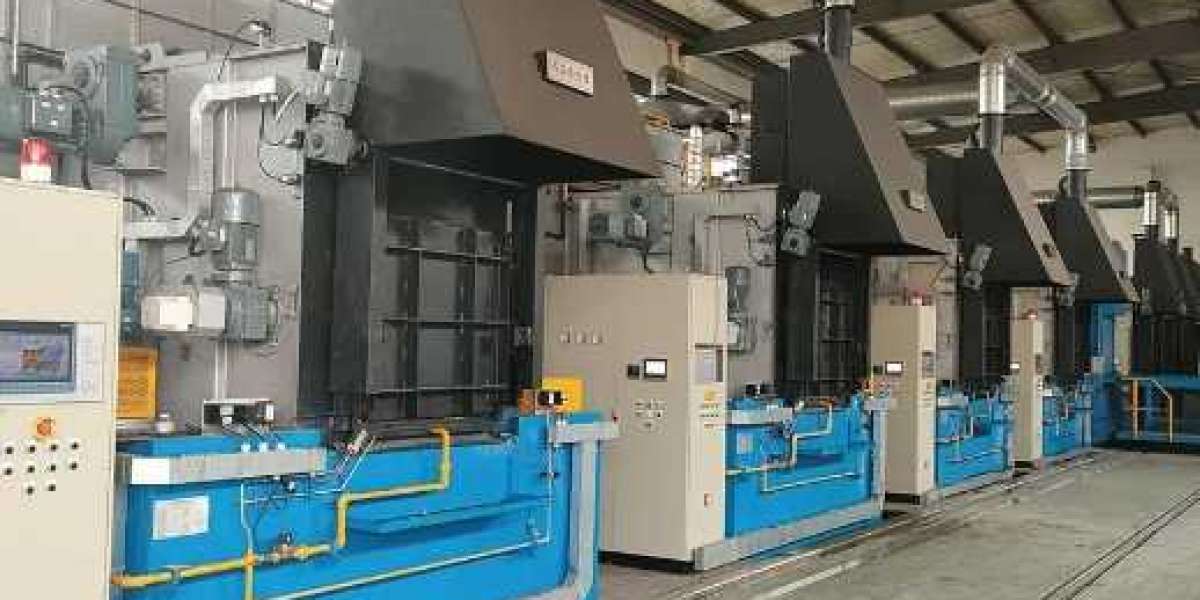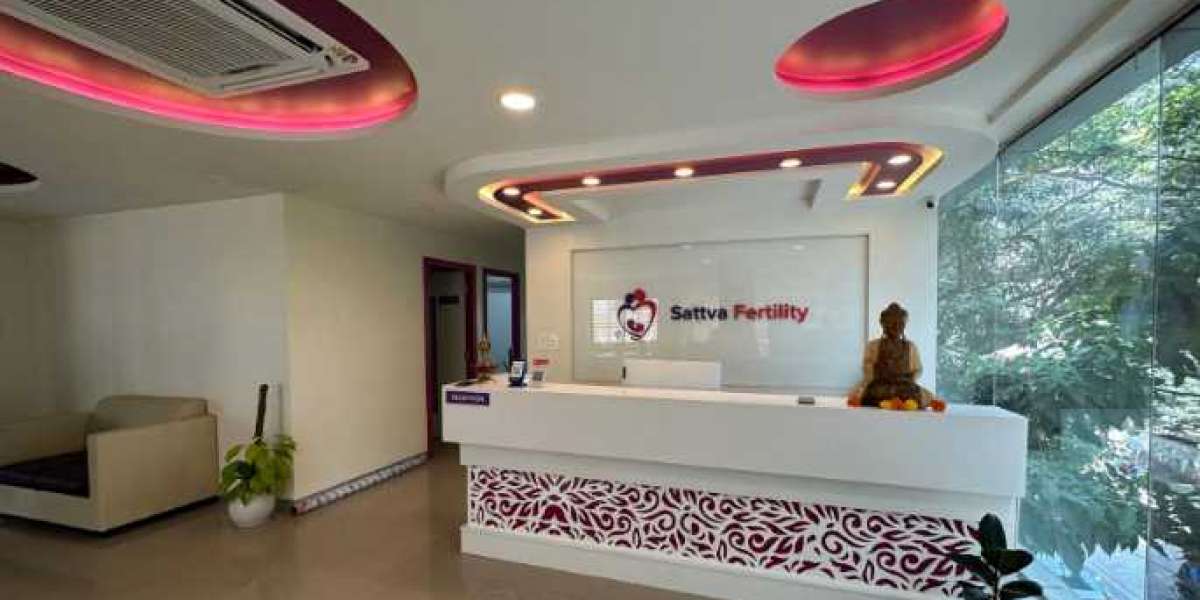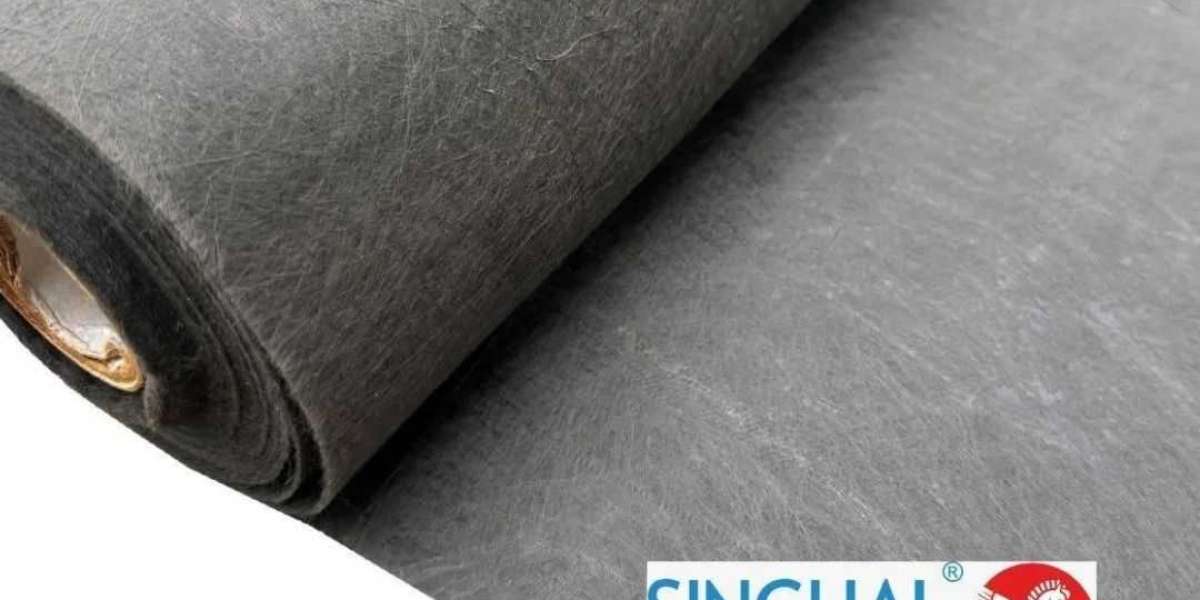How does the atmosphere in a furnace impact heat treatment processes?
Why is achieving temperature uniformity crucial in atmosphere furnaces?
What role do controlled atmospheres play in enhancing heat treatment processes?
How can efficiency and throughput be improved in operations involving atmosphere furnaces?
In the realm of industrial processes, an atmosphere furnace stands as a pivotal tool for controlled heating environments. This specialized furnace ensures precise temperature regulation within enclosed spaces, vital for various heat treatment applications such as annealing, brazing, and sintering. Utilizing protective gases or vacuum conditions, atmosphere furnaces shield materials from undesired reactions while optimizing desired outcomes through tailored atmospheres. The meticulous engineering behind these furnaces enables industries to achieve consistent results in material processing with enhanced efficiency and quality assurance.
Understanding Inert Atmosphere Furnaces
Purpose of Atmosphere Furnace
An atmosphere furnace serves a specific purpose in heat treatment processes. It ensures that materials are heated in a controlled environment to prevent undesired reactions. By using inert gases like argon or nitrogen, these furnaces create an oxygen-free atmosphere.
In industries such as aerospace, automotive, and electronics, preventing oxidation during heating is crucial for maintaining the quality of materials. For instance, in aerospace manufacturing, sensitive components must undergo precise heat treatments without being exposed to oxygen to avoid degradation.
Applications of Inert Atmosphere Furnaces
The versatility of atmosphere furnaces makes them indispensable across various sectors. Industries rely on these furnaces for processes like annealing and sintering where precise temperature control is paramount. They are vital for applications requiring the elimination of impurities through controlled heating.
Pros:
Prevents oxidation during heating processes.
Ensures high-quality outcomes in material treatments.
Cons:
Requires specialized training for operation.
Maintenance costs can be relatively high.
In the automotive industry, parts subjected to extreme temperatures need protection against oxidation to maintain their structural integrity over time. Similarly, electronic components benefit from inert atmosphere furnaces by avoiding contamination and ensuring consistent performance levels throughout their lifespan.
Importance of Furnace Atmosphere in Heat Treatment
Role in Material Properties
The atmosphere furnace is pivotal as it directly impacts the final properties of heat-treated materials. Different atmospheres, such as nitrogen or hydrogen, influence the outcome. For instance, using a nitrogen atmosphere can enhance surface hardness by introducing nitrogen into the material during treatment.
The choice of furnace atmosphere significantly affects crucial aspects like hardness and surface finish. Consider an example where steel parts are heat-treated in a controlled carbon-rich environment to improve wear resistance. This demonstrates how selecting the right atmosphere can tailor desired material characteristics.
Consistency and Quality Control
Maintaining precise control over the furnace atmosphere is vital for ensuring consistent and repeatable results in heat treatment processes. By regulating factors like gas composition and flow rate, manufacturers can achieve uniformity across batches. Consistent atmospheres lead to predictable outcomes, essential for meeting quality standards.
Pros:
Achieves specific material properties
Enhances surface finishes
Cons:
Requires meticulous monitoring
Mistakes may lead to inconsistent results
Role of Inert Gases in Heat Treating
Prevention of Oxidation
In atmosphere furnaces, inert gases such as nitrogen and argon play a crucial role in heat treating processes. By displacing oxygen, these gases effectively prevent oxidation during the heating process. This is essential because oxidation can negatively impact the properties of the metal being treated, leading to undesirable outcomes like surface scaling or decarburization. For instance, when steel is exposed to high temperatures without an appropriate atmosphere, it can react with oxygen from the air and form iron oxide on its surface.
In an atmosphere furnace, maintaining a stable environment is vital for achieving desired heat treatment results. Inert gases contribute significantly to this stability by creating a controlled atmosphere that minimizes reactions between the heated material and the surrounding air. By ensuring that oxidation is kept at bay through the use of inert gases, manufacturers can produce components with precise metallurgical properties and surface characteristics.
Temperature Uniformity Enhancement
Another key benefit of employing inert gases like nitrogen and argon in heat treating processes is their ability to enhance temperature uniformity within the furnace. When metals are subjected to varying temperatures across their surfaces during heating, it can lead to inconsistent mechanical properties after cooling down. By introducing inert gases into the furnace environment, manufacturers can achieve better temperature distribution throughout the workpiece being treated. This helps ensure that all parts of the metal receive uniform heating, leading to consistent hardness levels and microstructures once cooled.
The presence of inert gases also aids in reducing thermal gradients within the furnace chamber by promoting efficient heat transfer mechanisms across all areas where heat treatment occurs. This improved temperature uniformity not only enhances product quality but also contributes to minimizing distortion or warping issues commonly associated with uneven heating patterns.
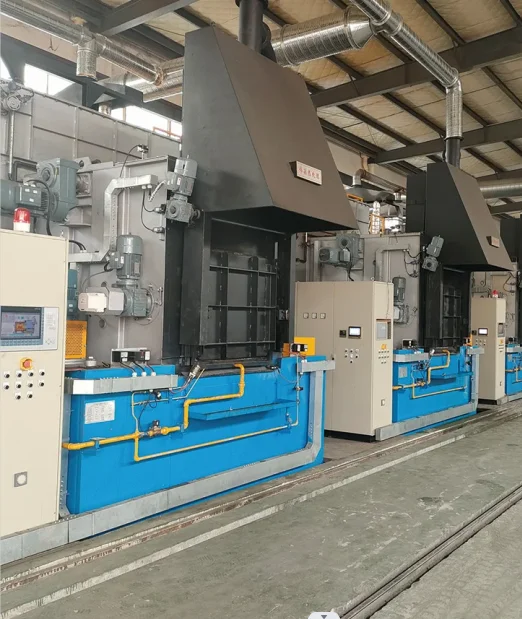
Different Types of Heat Treatment Furnace Atmospheres
Common Types
Furnace atmospheres like nitrogen, argon, hydrogen, and vacuum are commonly used in heat treatment processes. Each type offers unique benefits for various applications.
Nitrogen is often preferred for preventing oxidation during heat treatment, ensuring a clean surface finish. Argon provides an inert environment suitable for processes requiring minimal chemical reactions. Hydrogen is excellent for reducing oxides on metal surfaces, improving the overall quality of treated materials. Vacuum atmospheres eliminate impurities by creating a controlled environment with low oxygen levels.
Suitability and Factors
The choice of furnace atmosphere depends on several factors such as material composition, desired properties, and specific process requirements. For instance, when treating steel to enhance hardness, nitrogen or vacuum atmospheres are ideal due to their ability to prevent decarburization.
In contrast, if the goal is to minimize distortion during heat treatment while achieving high strength in alloys like titanium or nickel-based superalloys, using argon can be beneficial. Understanding the characteristics and advantages of each type helps manufacturers optimize their heat treatment processes effectively.
Controlled Atmospheres in Heat Treatment Processes
Precise Control for Desired Outcomes
Controlled atmospheres in an atmosphere furnace provide a way to precisely manage the environment inside. This control is crucial for achieving specific results during various heat treatment processes. By regulating factors like gas flow rates and composition, operators can tailor the atmosphere to meet the exact requirements of the process. For instance, when carburizing steel parts, introducing carbon monoxide into the furnace helps enrich the surface with carbon atoms, enhancing hardness.
In contrast, during annealing processes where softening or stress relief is needed, adjusting the atmosphere to be low in oxygen content prevents unwanted chemical reactions that could affect the material properties negatively. This level of precision ensures that each part being treated receives optimal conditions for its intended outcome.
Versatility and Flexibility
The flexibility offered by controlled atmospheres extends beyond basic heat treatments like carburizing and annealing. It also enables specialized processes such as brazing, where two metal components are joined using a filler material melted into a joint at high temperatures without melting the base metals themselves. In these cases, creating an environment free from contaminants like air ensures clean surfaces essential for successful brazing joints. The ability to customize atmospheres based on specific needs showcases how atmosphere furnaces are versatile tools in various industrial applications.
Pros:
Enables precise control over heat treatment processes.
Facilitates a wide range of specialized treatments like carburizing and brazing.
Enhances efficiency by providing tailored environments for different materials.
Cons:
Requires expertise to adjust gas compositions accurately.
Monitoring and maintaining controlled atmospheres can be complex.
Operational Aspects of Inert Atmosphere Furnaces
Proper Sealing for Maintaining Atmosphere
In atmosphere furnaces, maintaining the desired atmosphere is essential and requires proper sealing to prevent any leakage. The furnace must be tightly sealed to ensure that the inert gas used does not escape, thus preserving the controlled environment within. This helps in preventing oxidation or other unwanted reactions during heat treatment processes.
To illustrate, imagine a scenario where an atmosphere furnace is processing metal parts. If there are leaks in the seal, oxygen from the air can enter the furnace chamber and react with the metal at high temperatures, leading to undesirable outcomes like scaling or discoloration on the parts being treated.
Gas Flow Control Systems
Gas flow control systems play a vital role in regulating both composition and flow rates of gases within an inert atmosphere furnace. These systems allow operators to adjust parameters such as gas type, pressure, and volume accurately. By controlling these factors, they can create and maintain specific atmospheres required for different heat treatment processes.
For instance, when treating sensitive materials like titanium components in an inert atmosphere furnace, precise control over gas flow rates ensures that no impurities enter the chamber during heating cycles. This level of control guarantees that parts come out of the process with their desired properties intact.
Temperature Uniformity Monitoring
Temperature uniformity monitoring is crucial for achieving consistent results during heat treatments conducted in atmosphere furnaces. It involves ensuring that all areas within the furnace experience similar temperature profiles throughout a cycle. Variations in temperature can lead to uneven heating or cooling of parts, resulting in inconsistent material properties after treatment.

Achieving Temperature Uniformity in Atmosphere Furnaces
Proper Design and Insulation
Achieving temperature uniformity in atmosphere furnaces starts with proper furnace design and insulation. A well-designed furnace ensures heat is distributed evenly throughout the chamber, preventing hot spots or cold zones. The insulation plays a crucial role in retaining heat within the chamber, allowing for consistent temperatures across all parts of the furnace.
Proper design:
Even heat distribution
Prevents hot spots
Insulation:
Retains heat
Ensures consistent temperatures
Advanced Control Systems
Advanced control systems equipped with multiple thermocouples are essential for maintaining temperature uniformity in atmosphere furnaces. These thermocouples continuously monitor the temperature at various points within the heating chamber, providing real-time data to adjust heating elements as needed. By accurately controlling the temperature based on multiple measurements, these systems ensure that every part of the furnace reaches and maintains the desired temperature.
Control systems:
Multiple thermocouples
Real-time monitoring
Temperature adjustment:
Based on accurate data
Ensures desired temperature is reached
Regular calibration and maintenance of heating elements play a significant role in achieving temperature uniformity in atmosphere furnaces. Over time, heating elements may wear out or become less efficient, leading to inconsistencies in temperature distribution. By calibrating these elements regularly and ensuring they are well-maintained, operators can prolong their lifespan and maintain optimal performance.
Calibration and maintenance:
Prolongs lifespan of heating elements
Maintains optimal performance
Consistent maintenance also contributes to energy efficiency by ensuring that heating elements operate at their peak efficiency levels. Energy efficiency: - Consistent maintenance reduces energy consumption - Optimal performance leads to lower operating costs
By prioritizing proper design, advanced control systems with multiple thermocouples, regular calibration, and maintenance of heating elements, operators can achieve superior temperature uniformity throughout an atmosphere furnace's heating chamber.
Enhancing Efficiency and Throughput in Furnace Operations
Optimizing Loading Patterns
Maximizing furnace capacity by optimizing loading patterns is crucial for increasing throughput in heat treatment operations. By strategically arranging parts inside the atmosphere furnace, operators can ensure efficient use of space, leading to higher productivity. For example, placing smaller components closer together can help fill the furnace chamber effectively.
Automated Systems Implementation Implementing automated systems for loading/unloading and process control can significantly enhance efficiency in furnace operations. Automated processes not only streamline workflow but also reduce manual errors, ensuring consistent quality output. Utilizing robotics or conveyor belts for part transportation within the atmosphere furnace enhances operational speed.
Energy-Efficient Designs
Energy-efficient designs play a vital role in reducing heat loss and improving overall productivity in furnace operations. Proper insulation of the atmosphere furnace helps maintain stable temperatures inside, leading to energy savings and cost efficiency. Moreover, incorporating advanced technologies like vacuum pumps can further optimize energy consumption during heat treatment processes.
Maximizing furnace capacity through optimized loading patterns
Implementing automated systems for streamlined operations
Energy-efficient designs reduce heat loss and improve productivity
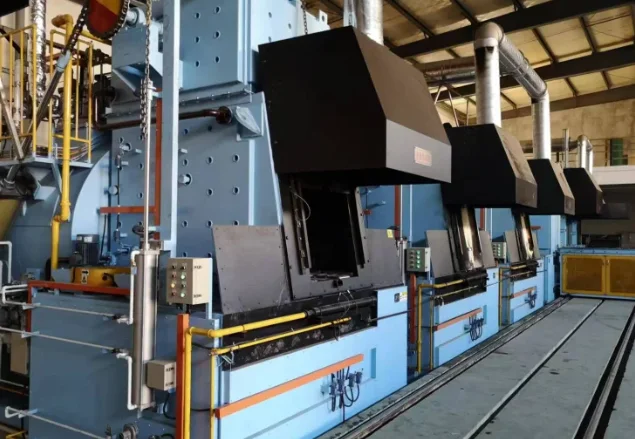
Final Remarks
The comprehensive exploration of inert atmosphere furnaces and their pivotal role in heat treatment processes underscores their significance in ensuring precise and controlled thermal processing. Understanding the nuances of furnace atmospheres and the impact of inert gases illuminates the intricate balance required for optimal heat treating outcomes. Different types of atmospheres offer varied benefits, each tailored to specific applications, emphasizing the versatility and adaptability of these furnaces. Operational considerations, such as temperature uniformity and efficiency enhancements, are crucial in maximizing performance and productivity.
For those involved in heat treatment operations, a meticulous approach to furnace atmospheres is paramount for achieving consistent results and operational excellence. By integrating best practices discussed in this article, individuals can elevate their understanding and application of inert atmosphere furnaces, paving the way for enhanced heat treatment processes. Continual learning and refinement in this field are key to unlocking the full potential of atmosphere furnaces for various industrial applications.
Frequently Asked Questions
What are the key components of an inert atmosphere furnace?
An inert atmosphere furnace typically consists of a heating chamber, gas flow control system, temperature controls, and a purging system to maintain low oxygen levels.
How does the atmosphere in a furnace impact heat treatment processes?
The type of atmosphere used in a furnace significantly influences the outcome of heat treatment by affecting material properties such as hardness, strength, and surface finish.
Why is achieving temperature uniformity crucial in atmosphere furnaces?
Uniform temperature distribution ensures consistent heat treatment results across all parts within the furnace chamber, preventing variations in material properties due to uneven heating.
What role do controlled atmospheres play in enhancing heat treatment processes?
Controlled atmospheres help regulate chemical reactions during heat treatment, prevent oxidation or decarburization of materials, and enable precise control over material characteristics.
How can efficiency and throughput be improved in operations involving atmosphere furnaces?
Efficiency and throughput can be enhanced by optimizing heating cycles, reducing idle time between batches, implementing automated systems for process monitoring and control.
